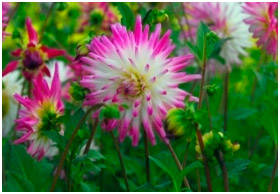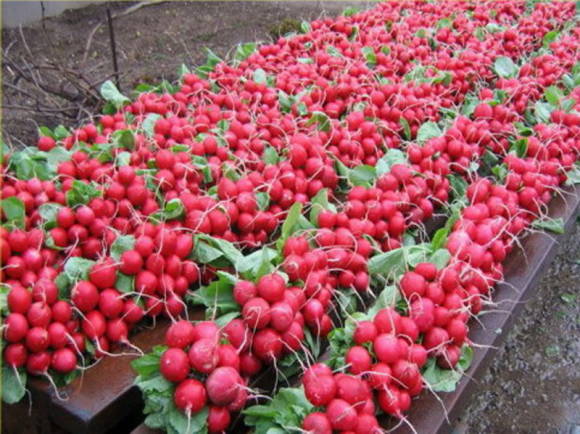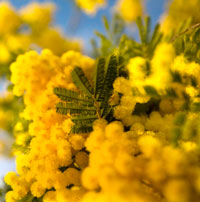When growing a number of plants, gardeners often face problems that relate to the specific requirements for their growing conditions. As an example, we can cite representatives of the heather family: heather, erica, wild rosemary, blueberries, blueberries, cranberries, lingonberries, etc., as well as representatives of other families and classes: hydrangeas, ferns, etc.
Many summer residents grow these crops on their plots. Someone succeeds immediately, while others have problems. One of the main ones is the pH of the soil, which does not meet the requirements of plants.
 In nature heather grow on different soils: sand, sandy loam, peat bogs. But all species of this family have a common feature that must be taken into account when growing them. They all love light and very acidic soils (the optimum soil pH for heather is 3.5-4.5 units). This is explained by the peculiarities of the structure of the root system and nutrition of these plants.
In nature heather grow on different soils: sand, sandy loam, peat bogs. But all species of this family have a common feature that must be taken into account when growing them. They all love light and very acidic soils (the optimum soil pH for heather is 3.5-4.5 units). This is explained by the peculiarities of the structure of the root system and nutrition of these plants.
The thing is that on the roots of heathers there are no root hairs that absorb water and minerals from the soil. The role of root hairs is played by mycorrhiza (these are microscopic fungi that live in symbiosis with plant roots). In heather, mycorrhiza is endotrophic, i.e. the cells of the fungus live in the cells of the root cortex, from which separate hyphae of the fungus stick out. Due to this, the fungus absorbs water from the soil with salts dissolved in it and provides the plant with them, and this, in turn, shares organic substances with the fungus. The existence of such cohabitation is beneficial for both species, but there is one "but". Mycorrhiza can work with a sufficient amount of oxygen in the soil and only in an acidic environment. When the pH of the soil rises to 6-7 units, mycorrhiza is unable to perform its function, so the plant remains hungry even in very rich soil. Heather plants stop growing, the foliage turns light green, then turns yellow, i.e. all the signs of chlorosis from lack of nutrition are manifested. Conversely, even in poor but very acidic soil, heather plants thrive.
Soil acidification quickly removes signs of nutritional deficiencies and normalizes plants. Therefore, before planting any plant from this family, make sure that the soil is very acidic and has a suitable texture. I would like to note that some varieties of heather initially have a golden, bronze or yellow color of the leaves, this should be taken into account when assessing the state of your plantings.
 Similar problems arise when growing other "lovers" of acidic soil. Hydrangeas, ferns, all heathers, as well as lingonberries grow well on peat bogs, sands and sandy loam substrates with rotted deciduous litter, which significantly improves the water regime and soil fertility. The soil suitable for growing such plants can be created in any garden plots using peat, foliage, bark, sawdust or other acidic materials, bringing their acidity (pH) to 3.5-4.5 using sulfur, or better - spilling acidified water (10 liters of solution per 1 m). For acidification, you can use citric or oxalic acid (at the rate of 1.5-2.0 tablespoons per 10 liters of water), as well as vinegar or apple cider 9% (at the rate of 100 g of vinegar per 10 liters of water). But it is best to use a battery electrolyte (this is diluted sulfuric acid). I would like to warn gardeners that only unused electrolyte can be used for acidification, the spent electrolyte cannot be used in any case, since heavy metals, in particular lead, accumulate in it. And then harmful substances will get into the soil, and then into food. Fresh electrolyte, on the other hand, contains practically no impurities, and sulfuric acid residue (SO4) is an important component of fertilizers used for feeding heathers.Sulfur included in it is a very valuable trace element that plays an important role in the metabolism and nutrition of plants.
Similar problems arise when growing other "lovers" of acidic soil. Hydrangeas, ferns, all heathers, as well as lingonberries grow well on peat bogs, sands and sandy loam substrates with rotted deciduous litter, which significantly improves the water regime and soil fertility. The soil suitable for growing such plants can be created in any garden plots using peat, foliage, bark, sawdust or other acidic materials, bringing their acidity (pH) to 3.5-4.5 using sulfur, or better - spilling acidified water (10 liters of solution per 1 m). For acidification, you can use citric or oxalic acid (at the rate of 1.5-2.0 tablespoons per 10 liters of water), as well as vinegar or apple cider 9% (at the rate of 100 g of vinegar per 10 liters of water). But it is best to use a battery electrolyte (this is diluted sulfuric acid). I would like to warn gardeners that only unused electrolyte can be used for acidification, the spent electrolyte cannot be used in any case, since heavy metals, in particular lead, accumulate in it. And then harmful substances will get into the soil, and then into food. Fresh electrolyte, on the other hand, contains practically no impurities, and sulfuric acid residue (SO4) is an important component of fertilizers used for feeding heathers.Sulfur included in it is a very valuable trace element that plays an important role in the metabolism and nutrition of plants.
To acidify the soil before planting heathers, you can use either a ready-made electrolyte or sulfuric acid for its preparation. But at the same time, the amount of electrolyte or the amount of acid used to prepare the solution will differ significantly. The fact is that the concentration of sulfuric acid in an electrolyte solution directly depends on its density. If you bought an electrolyte with a solution density of 1.22 g / cm2, then you have a 30% sulfuric acid solution. If the density of the solution is 1.25 g / cm2, then the acid concentration in it increases to 34%. The density of a solution of 1.30 g / cm2 corresponds to 40% concentration, 1.39 g / cm2 to 50%, etc. At a density of 1.80 g / cm2, the acid content in the solution reaches 88%, and concentrated sulfuric acid has a density of 1.84 g / cm2. Read the label very carefully before preparing the solution.
But the amount of electrolyte or acid for preparing a solution that acidifies the soil depends not only on its density or percentage concentration, but also on the pH of the water used for this purpose. For example, 1 ml of electrolyte with a density of 1.22 g / cm2, dissolved in 1 liter of water, the pH of which is 7, reduces this indicator from 7 to 5 units. Accordingly, the lower the pH of the water and the higher the density of the electrolyte solution, the less sulfuric acid is needed to prepare the solution.
 Before acidifying the soil on your site, you need to determine the initial indicators, i.e. the natural acidity of the soil and the acidity of water used for irrigation and preparation of an acidifying solution. If the pH of the soil and water is within 3-5 units, then there is no need to acidify - all the plants mentioned above will feel great. If these indicators are 6, 7, 8 or more units, it is necessary to acidify the soil, otherwise your heathers, ferns, etc. will have problems with the assimilation of nutrients from the soil. It is necessary to calculate the amount of electrolyte added per 1 liter of water based on the natural pH values of the site's soil and water. If the pH of the soil and water in your area is 6 units, such soil should be shed with a solution, the pH of which is 2-3 units. To do this, add 2-3 ml of electrolyte with a density of 1.22 g / cm2 to 1 liter of water with a pH of 6. If you have a sulfuric acid solution with a density of 1.81 g / cm2 (90%), then its amount decreases to 0.5-0.7 ml per 1 liter of water, etc. The ratio of the amount of electrolyte and water for the preparation of an acidifying solution must be calculated for each specific case separately. Therefore, a modern gardener needs a device such as a pH meter. Cheap household appliances are now on sale. You can replace the pH meter with a paper soil acidity tester, which is available in packs at many garden centers and shops.
Before acidifying the soil on your site, you need to determine the initial indicators, i.e. the natural acidity of the soil and the acidity of water used for irrigation and preparation of an acidifying solution. If the pH of the soil and water is within 3-5 units, then there is no need to acidify - all the plants mentioned above will feel great. If these indicators are 6, 7, 8 or more units, it is necessary to acidify the soil, otherwise your heathers, ferns, etc. will have problems with the assimilation of nutrients from the soil. It is necessary to calculate the amount of electrolyte added per 1 liter of water based on the natural pH values of the site's soil and water. If the pH of the soil and water in your area is 6 units, such soil should be shed with a solution, the pH of which is 2-3 units. To do this, add 2-3 ml of electrolyte with a density of 1.22 g / cm2 to 1 liter of water with a pH of 6. If you have a sulfuric acid solution with a density of 1.81 g / cm2 (90%), then its amount decreases to 0.5-0.7 ml per 1 liter of water, etc. The ratio of the amount of electrolyte and water for the preparation of an acidifying solution must be calculated for each specific case separately. Therefore, a modern gardener needs a device such as a pH meter. Cheap household appliances are now on sale. You can replace the pH meter with a paper soil acidity tester, which is available in packs at many garden centers and shops.
To maintain the optimal level of soil acidity during the growing season, it is advisable to water the area with heather acidified water once every 10-15 days (or at least once a month), the same as when preparing the soil for planting. The fact is that the soil is a buffer system, it quickly restores its original properties (including the original acidity). Deacidification occurs due to irrigation with neutral or alkaline water (this may be in your well or plumbing), due to rain and groundwater.
 I would also like to say about cultivation HORTENSIUM... The fact is that the color of the inflorescences of these plants is mainly determined by the pH of the soil on which they are grown. On very acidic soil (pH 2-4.5), hydrangea inflorescences are blue or blue-violet. On slightly acidic soil (pH 5-6), the bushes adorn the caps of white flowers, and on neutral or slightly alkaline (pH 7-8), the color of the inflorescences changes to pink. By adjusting the pH of the soil under the hydrangeas, you can achieve a variety of colors of their flowers.But this effect is manifested only if the soil pH is constantly maintained at the same level during the entire growing season, starting from the moment of sap flow (1-2 days of March). How to lower the pH level to 3-4 units is described in detail above. You can raise the pH to the desired level with dolomite flour. It is brought in in February-March, because {it acts slowly. During the growing season, the pH can be maintained at a level of 7-8 units with the help of water, to which lime is added and its pH is brought to 9-10 units. To control the pH of the soil and the solutions used to regulate this indicator, you can either use a pH meter or a paper determinant of soil acidity.
I would also like to say about cultivation HORTENSIUM... The fact is that the color of the inflorescences of these plants is mainly determined by the pH of the soil on which they are grown. On very acidic soil (pH 2-4.5), hydrangea inflorescences are blue or blue-violet. On slightly acidic soil (pH 5-6), the bushes adorn the caps of white flowers, and on neutral or slightly alkaline (pH 7-8), the color of the inflorescences changes to pink. By adjusting the pH of the soil under the hydrangeas, you can achieve a variety of colors of their flowers.But this effect is manifested only if the soil pH is constantly maintained at the same level during the entire growing season, starting from the moment of sap flow (1-2 days of March). How to lower the pH level to 3-4 units is described in detail above. You can raise the pH to the desired level with dolomite flour. It is brought in in February-March, because {it acts slowly. During the growing season, the pH can be maintained at a level of 7-8 units with the help of water, to which lime is added and its pH is brought to 9-10 units. To control the pH of the soil and the solutions used to regulate this indicator, you can either use a pH meter or a paper determinant of soil acidity.
With poor assimilation hydrangeas nutrients from the soil, as evidenced by the pale green color of the leaves and weak shoot growth (a consequence of the high pH level of the soil), you can feed them through the leaves. For this, hydrangea bushes are sprayed with a weak solution of fertilizers (2-3 g per 10 l of water) 2-3 times a month.







